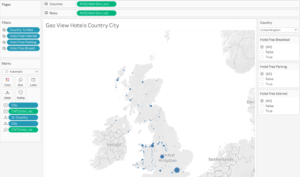
Derive Insights in Real-Time Using Data Visualization and Analytics

(Digital_Art/Shutterstock)
For enterprises to compete in an increasingly crowded and distributed market, it’s critical they understand that modern applications require both operational processing of transactions and interactions, along with real-time analytics processing that drives application features for improved customer experience.
To effectively derive meaningful business insights from real-time operational data, a combination of analytics and data visualization are imperative.
Why Analytics and Data Visualization Are Key for Modern Enterprises
It’s clear that modern enterprises require operational processing of transactions, interactions, and analytics to meet the evolving demands of today’s global customers. By leveraging analytics and data visualization, organizations can identify correlations in relationships by connecting the dots between independent variables, allowing users to make more strategic business decisions to improve the customer experience.
Analytics and data visualization can also be applied to analyze trends over time. It’s impossible to make predictions without having the necessary historical data that can help organizations identify recurring trends that can inform strategies for future opportunities. The frequency of variables is closely related to trends over time. For example, examining how and when consumers purchase and use items allows businesses to glean insights on opportunities to innovate and the most effective ways to engage existing and potential new customers.
Benefits and Use Ccases for Modern Data Visualization
Data visualization allows businesses to recognize patterns more quickly because they can interpret data in digestible graphical or visual forms. It empowers users to comprehend large amounts of data at a glance, augmenting their ability to understand the effectiveness of existing strategies, as well as ways to improve internal processes.
When done right, data visualization also helps increase sales with existing customers and target new markets and demographics for potential new business. Below are several use cases for data visualization in healthcare, energy, and retail and food industries.
- Energy: Offshore oil rigs generate a great deal of data that needs to be collected and consolidated. At first glance, it’s filled with difficult-to-decipher decimals and data points, but when it’s converted into a visual graph, it becomes easier to interpret. The data is then segmented based on various attributes including environmental factors, temperature, pressure, flow rate and more. By visualizing the data in a digestible manner using Tableau, for example, users can derive insights that help manage and forecast production and demand for oil. This is particularly important during times with rising gas prices—research shows that failing to take advantage of data and analytics contributes to inefficiency and lower production in oil and gas companies. With the right database and data visualization tool, processing facilities can handle more data, driving real-time analysis that helps oil and gas operations run more efficiently, which is crucial for better production rates.
- Healthcare: Hospitals and clinics rely on data visualization to help optimize their revenue. From the data perspective, they’re interested in understanding what procedures are being performed, why and when patients are making appointments, how often doctors are seeing patients, etc. Throughout the pandemic, hospitals were fully booked with COVID patients, but experienced a decline in scheduled appointments and procedures for visits including non-urgent surgeries and annual check-ups. This had a direct impact on revenue, and with all the new data coming in, simply looking at data tables is not sufficient in drawing meaningful conclusions. Data visualization plays a big role when extracting outliers and insights, especially since healthcare data comes in from various sources including service providers, customers and insurance agencies.
- Retail and food: When it comes to the retail and food industries, there’s a laundry list of consumer behaviors to take into consideration when making business decisions: frequency of purchases, clothing size and department, fresh or frozen food—the list goes on. An important metric for retailers is the GMV (gross merchandise value) number which enables them to calculate the allocation of earnings based on the products and variables that are being tracked. By putting all of this data in a visual graph or chart, users can glean insights and cross reference consumer buying patterns.
Data visualization is also helpful when grocery chains or department stores are developing promotional offers and analyzing how often and when consumers are taking advantage of membership program benefits. When all of this scattered data is pieced together, especially when the platform can deliver real-time insights, businesses can make forward-thinking decisions that impact overall growth, sales, and customer experience. Data is the consumer story, and visualization tools help piece it together.
Selecting the Right Vendor
Some of the key challenges in implementing analytics involve navigating a complex system, overall costs and the time it takes to get to insights. A data visualization and analytics solution must be robust, scalable and simultaneously easy for users to extract conclusions from the data. When data is stored as JSON style documents, complexity is introduced. That’s why, when selecting a data visualization tool, it needs to connect and be compatible with data sources that enable users to unpack intricacies. This includes the ability to handle operational and analytical data from a single system.
An ideal solution should also allow teams to create visualized analytics within a dashboard, for example, which can provide schema and data attributes including character, number, and date and time. This format makes the data structures more concise and focused. The platform should also have manageability and security, while also delivering extremely affordable total cost of ownership.
Furthermore, users must be able to address the who, the when (timing), the what and the where. These variables can be combined and transformed into the appropriate visualization format—like a heat map, depending on the data. And as data sources proliferate, the solution should also have the ability to bring in machine learning data and data that is sitting in systems outside of traditional data platforms.
Bottom line, data visualization and analytics empower organizations to develop rich, interactive dashboards and reports to measure their business performance and enable agile decision making. By leveraging NoSQL document data in real time, users can analyze data instantly without the need to perform any data transformations.
About the author: Idris Motiwala is a senior principal product manager at Couchbase. He has more than 20 years of experience in design, development, and execution of software products at both Fortune 500s and startups, leading teams in digital transformation, cloud and analytics. Idris holds an MS in Technology Management and certifications in product management.
Related Items:
Visualizations That Make You Go ‘Hmmm’
How Data Visualization Drives Better Business Decisions and Outcomes
Big Data Outlier Detection, for Fun and Profit




























